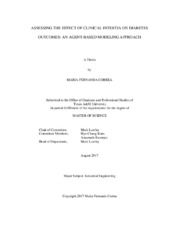| dc.description.abstract | Clinical inertia (CI) is the failure to intensify treatment in patients with evidence of poor glycemic control. It is a critical barrier in the effective management of type 2 diabetes and can have adverse effects, such as elevated risk of diabetes-related complications. The aims of this thesis are to study the long-term effects of CI and its interaction with population characteristics on the incidence of diabetes-related complications. An agent-based simulation has been constructed to study these effects. The base model was developed by researchers from The New York Academy of Medicine and the Icahn School of Medicine at Mount Sinai. It was then extended by adding an HbA1c update formula and treatment intensification processes, which offers a flexible avenue through which to compare diverse populations and parameters in a controlled and systematic approach.
To assess the accuracy of our model, we have conducted model validation using 5 published trials and compared the rates of complication incidence. We performed 12 validation exercises, comparing simulated outcomes with published outcomes. The R-square of the overall fit was 0.9065, indicating overall good agreement between the outcomes. Thus, we concluded that the model was reliable for modeling the progression of diabetes-related complications in a population.
Additionally, we performed a series of experiments to meet our aims. The results indicated that a 1-year, 3-year, and 7-year CI significantly increases the 25-year cumulative incidence of most diabetes complications when compared to the non-CI group. It also indicates that CI has greater impact on specific race and age-group populations; for example, the 65-100 age-group experienced a significantly higher percent increase in the incidence of myocardial infarction, stroke, and retinopathy in comparison to the 45-64 age-group while experiencing a 3-year CI. Additionally, it indicates that the incidence of neuropathy and nephropathy due to a 3-year CI in a Native American population is significantly less than the non-Hispanic White, African American, Hispanic, and Asian populations undergoing a 3-year CI. Our model results provide insightful information for the development of effective diabetes treatment guidelines. Future research is needed to investigate the mechanism behind the differences among different population groups. | en |


